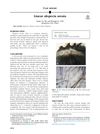Moth-Eaten Alopecia as a Manifestation of Various Skin Diseases: Reporting a Series of 100 Cases
December 2021
in “
Journal of clinical images and medical case reports
”

TLDR Moth-eaten alopecia is linked to various skin diseases and requires early treatment to prevent worsening.
The observational study analyzed 100 patients with moth-eaten alopecia, a type of hair loss characterized by small, ill-defined patches. The patients ranged from 3 to 48 years old. The study identified the most common skin diseases causing this hair loss as lichen planopilaris (32% of patients), discoid lupus erythematous (26%), alopecia areata (11%), chronic folliculitis (9%), striae distensae (9%), scalp morphea (7%), tinea capitis (4%), and juicy psoriasis (2%). The research concluded that moth-eaten alopecia is a unique pattern of hair loss associated with many skin diseases, and early diagnosis and treatment are crucial to prevent disease progression and further scarring.

